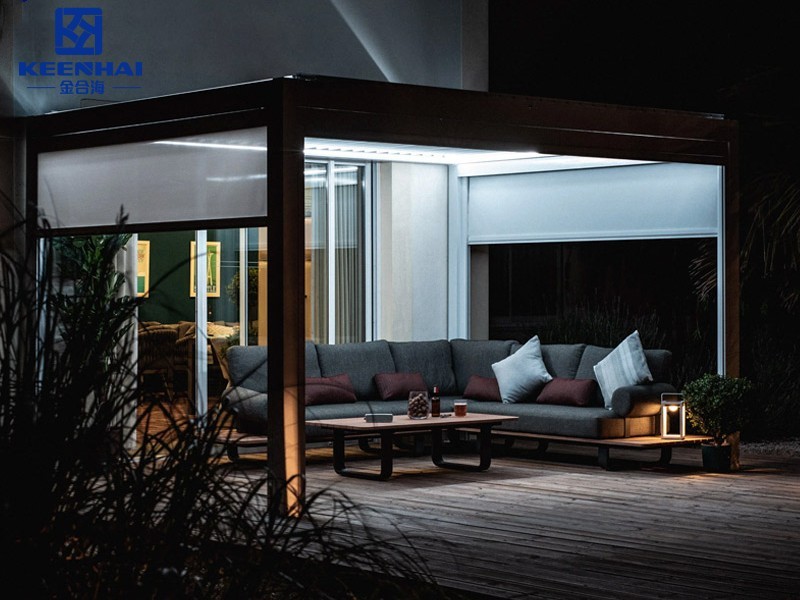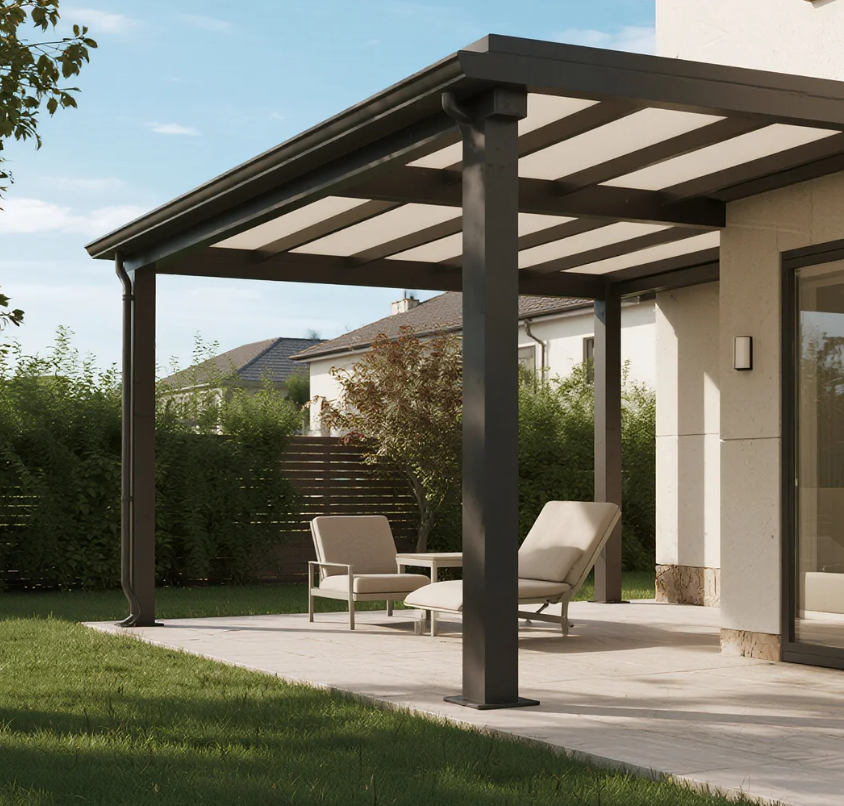
1.1 What Makes a Pergola Unique
Open-Air Framework with Defined Boundaries
A pergola stands out because it creates a framed space without closing you in. Homeowners love the way the beams and posts mark out a dining zone or a lounge corner while keeping the air flowing. The roof, made of slats or louvers, doesn’t block the sky completely—it filters it. That balance between openness and structure gives it a signature look.
Adjustable Shade and Modern Options
Unlike a flat patio surface, a pergola adds vertical dimension and control. Many families now choose an Aluminum Prefab Pergola because the louvers rotate. On hot days, you tilt them shut for shade; in the evening, you open them up to catch the breeze. This flexibility makes a pergola feel like part of the house, not just an outdoor add-on.
A Real-World Scenario
Picture a backyard in Phoenix: the owner installed a slim-frame Aluminum pergola house connected to the sliding doors. During the afternoon, the slatted roof protects the outdoor dining table from harsh sunlight. At night, LED strips built into the beams turn the space into a soft-lit lounge. That mix of protection and atmosphere is exactly why people invest in pergolas.
1.2 Defining Features of a Patio
Ground-Level Foundation
A patio is essentially a flat surface built directly on the ground, often made of concrete, stone, or pavers. It doesn’t introduce vertical shade elements like a pergola does. Instead, its main role is to provide a sturdy, level area for seating, barbecues, or fire pits. Think of it as the outdoor floor, not the outdoor ceiling.
Simplicity and Cost Control
Patios usually cost less to build and maintain than a pergola. For homeowners on a budget, a patio delivers function without requiring posts, beams, or overhead systems. But this simplicity comes with trade-offs—no built-in shade, no architectural height, and less visual impact on property value.
Quick Comparison
To make the differences more tangible, here’s a straightforward comparison:
| Feature | Pergola | Patio |
|---|---|---|
| Vertical Structure | Yes | No |
| Provides Shade | Adjustable louvers or slats | Requires umbrella or cover |
| Material Options | Aluminum, wood, vinyl | Concrete, stone, brick |
| Impact on Home Value | Higher (architectural feature) | Moderate (basic outdoor surface) |
| Typical Use | Defined lounge/dining area | General outdoor ground space |

2. Function and Everyday Use
2.1 Shade, Shelter, and Comfort
A well-designed outdoor structure is more than decoration—it’s about livability. A modern aluminum gazebo, for instance, transforms a bare deck into a sheltered extension of the home. The roof blocks midday sun while the open sides keep the space ventilated. Families in humid climates often add ceiling fans under the beams, turning the area into a breezy retreat even during summer heat. It’s not just shade, it’s usable comfort that extends your day outside.
When clients ask how to maximize comfort, we often recommend three practical steps:
-
Install adjustable louvers or screens to control airflow.
-
Add integrated lighting so the space works after dark.
-
Include weatherproof furniture that stands up to rain and UV exposure.
These details make the difference between a decorative structure and a daily living zone.
2.2 Social and Lifestyle Applications
Unlike a simple patio, a pergola invites people to gather. Picture a weekend in Los Angeles: friends sit under a keenhaipergola-designed frame with string lights overhead, while the barbecue sizzles a few feet away. That combination of structure and openness creates an atmosphere that patios alone can’t deliver.
In many suburban homes, homeowners also use the pergola as a multi-purpose hub:
-
Breakfast spot in the morning sun.
-
Outdoor office with a laptop during the day.
-
Family dining table under soft lighting at night.
The versatility matters. Instead of being limited to fair-weather afternoons, the right pergola setup lets you use your backyard like another room of the house.

3. Materials and Installation
3.1 Pergola Construction Styles and Options
When people choose a pergola, one of the first decisions is the material. Aluminum pergolas are becoming the go-to option because they don’t rust, and they keep their clean finish even after years of rain and sun. Imagine a backyard in Phoenix where summers hit 110°F—wood beams would warp and crack, but an aluminum frame stays straight and smooth. Wood pergolas still have their charm, especially in traditional garden settings, but they require yearly sealing and staining to avoid rot. Vinyl is the budget-friendly choice; it’s easy to maintain but doesn’t offer the same structural strength for larger spans. The style you pick also matters—some homeowners go with a modern flat-roof louvered design, while others prefer arched beams for a softer, rustic look.
3.2 Patio Surfaces and Build Process
A patio, on the other hand, starts from the ground up. The surface material sets the tone of the entire space. For example, a stamped concrete patio in California can mimic natural stone but at a fraction of the price, while brick gives a warm, classic feel in older neighborhoods. Pavers are also popular because they can be replaced one by one if damaged. The installation process is straightforward but needs precision:
-
The ground must be leveled and compacted.
-
A gravel base is laid for drainage.
-
Sand or mortar is added depending on the surface type.
-
Finally, the bricks, stones, or concrete slabs are set and sealed.
In real projects, patios are often paired with pergolas to create a complete outdoor room. For example, a family in Austin built a paver patio and topped it with a louvered aluminum pergola, adding both shade and a hard surface for outdoor furniture. The result was a space they could use year-round—coffee mornings in spring, shaded lunches in summer, and even a heater under the pergola for chilly fall nights.

4. Cost and Value Considerations
4.1 Initial Investment: Pergola vs. Patio
The cost difference between a pergola and a patio usually starts with materials and labor. Building a standard patio with pavers or stamped concrete might cost anywhere from $20 to $40 per square foot, depending on the finish. A basic wood pergola could be in a similar range, but once you switch to aluminum or add motorized louvers, the price climbs. For example, in Florida, a 12x16 aluminum louvered pergola can cost close to $15,000, while a paver patio of the same footprint may run half that.
4.2 Long-Term Maintenance and Upkeep
Where value really shows up is in the long run. A wood pergola looks great the first year, but it needs resealing, repainting, or sometimes even beam replacements after a few seasons. Aluminum pergolas, on the other hand, hold their finish and usually come with 10–20 year warranties. Patios depend heavily on the surface material. Concrete may crack after freeze-thaw cycles in northern states, while pavers can shift if not installed properly. Regular sealing and the occasional repair add to the total cost of ownership.
4.3 Return on Investment and Lifestyle Value
Homeowners often ask if these upgrades add to property value. The answer is yes, but it depends on execution. A patio paired with a pergola feels like an extension of your home, essentially creating an outdoor living room. Real estate agents in places like Texas often highlight these features in listings because buyers can imagine family gatherings, summer cookouts, or quiet mornings with coffee. While the financial return varies, the lifestyle upgrade is immediate. You’re not just building a structure—you’re creating a space where people want to spend time.
